The PNW abounds with a huge variety of native and imported plants. Unfortunately, some of these plants are toxic to livestock. Signs of toxicity can range from as mild as brief indigestion to as severe as sudden death. It behooves all livestock producers to become familiar with the toxic plants growing in areas where he/she pastures or houses animals.
This article is in no way meant to be an exhaustive list of all the PNW’s poisonous plants. The plants discussed here were selected because of their ability to cause serious illness, abundance in the PNW or other special factors. To learn about other potential sources of plant toxicity, producers are encouraged to consult the references cited at the end of this article.
Wild cherry, chokecherry, black cherry, peach, apricot and cherry laurel (Prunus species) have poisonous leaves, twigs and bark. The toxic agent is a cyanogenic glycoside which makes hemoglobin unable to release oxygen at the tissue level. Signs of poisoning appear rapidly and are those of cyanide toxicity: difficulty breathing, excitement, tremors, gasping, dilated pupils, bright pink mucous membranes, bloat, staggering, involuntary urination and defecation, convulsions, coma and death due to asphyxiation. Blood and mucous membranes of affected animals are bright red. Livestock ingest Prunus plant material when other forage is unavailable and out of curiosity when a branch falls into a pasture. Fruit from Prunus species is not poisonous but seeds and pits are. Treatment includes sodium nitrite and sodium thiosulfate; many cases die too quickly to receive treatment. During autopsy, an odor of bitter almonds can sometimes be detected in the rumen.
Japanese Yew (Taxus cuspidata) is a common ornamental shrub that is extremely toxic due to the presence of taxine, ephedrine and cyanide alkaloids. Leaves, twigs and seeds are toxic. Livestock can ingest this plant if they gain access to landscaped lawns or if homeowners trim yew shrubs and give the trimmings to livestock. Signs of poisoning include vomiting, diarrhea, bloat, weakness, nervousness, trembling, difficulty breathing, incoordination, dilated pupils, decreased heart rate, convulsions, coma and death due to cardiac standstill. Treatment with atropine may be somewhat helpful but most cases are fatal. On autopsy, yew plant parts can be identified in stomach or rumen contents.






Oleander (Nerium oleander) is another extremely toxic ornamental shrub. All fresh or dry parts of the plant are toxic. A digitoxin-like cardiac glycoside, oleandrin, is responsible for this plant’s toxicity. Signs of poisoning appear quickly and include severe vomiting and diarrhea, swollen and inflamed oral tissues, cold extremities, dilated pupils, increased heart rate, weakness and death. Food that has touched an oleander should be considered toxic, as should smoke made from a fire fueled with oleander. Treatment with atropine and propranolol may lessen cardiac effects somewhat but most cases are usually fatal.
Deathcamus (Zigadenus venenosus and other species) is the broad name given to a genus of at least four species of native perennial herbs that are found throughout the West. This toxic plant can cause human poisoning if its bulbs are confused with onions or camas (Camassia quamash). Toxicity is due to zygacine, a steroidal alkaloid. Deathcamus is of particular concern in the early spring because it is one of the first green plants to emerge and will therefore be attractive to grazing livestock, especially sheep. All parts of the plant are toxic, particularly the bulbs; all species of livestock can be affected. Signs of poisoning include incoordination, staggering, rapid pulse and respiration, excessive salivation, frothing from the mouth, vomiting, coma and death due to heart failure. Post mortem findings can include hemorrhage and severe congestion of lungs. Treatment with atropine and picrotoxin may alleviate signs to some degree.


Pigweed (Amaranthus species) is a common weed that can be found in pastures, rangeland and even corrals. It accumulates toxic levels of nitrates, especially after treatment with herbicides; it can also contain oxalates. It is not particularly palatable unless it is young or has been damaged by herbicides. Animals may ingest pigweed due to boredom or lack of other forage. Cattle and other ruminant species account for most cases of poisoning. Nitrates in the ingested plant are metabolized into nitrites, which bind to hemoglobin and make it unable to carry oxygen. Signs can be rapidly progressive and include tremors, increased but weak pulse, decreased temperature, weakness, staggering, difficulty breathing, brown or blue mucous membranes, nervousness, frequent urination, collapse, coma and death; surviving animals may abort. Blood of affected animals is dark red or brown. Intravenous treatment with methylene blue should be performed by a veterinarian.
Lambsquarter (Chenopodium album) is a common weed that contains oxalates and nitrates in its leaves and stems. Signs of poisoning in cattle include difficulty breathing, diarrhea, recumbency, coma and death if a large amount is ingested. Refer to pigweed above for more information on nitrate poisoning.
Greasewood (Sarcobatus vermiculatus) is a common native range shrub found on alkaline or saline bottom land. It can be grazed safely if animals also ingest other non-toxic plants; toxicity occurs when large amounts of greasewood are consumed over a brief time period. Toxicity is due to oxalates that are concentrated in the leaves. Although ruminants are more resistant to the effects of oxalates than are monogastrics, cattle and sheep account for the majority of clinical cases due to their access to rangeland. Signs of poisoning reflect the hypocalcemia caused by oxalates (weakness, depression, weak pulse, gastrointestinal paralysis, recumbency) in addition to salivation, gastrointestinal irritation (vomiting, diarrhea), difficulty breathing, coma and death. Post mortem findings can include swollen kidneys, hemorrhage of rumen wall and excessive fluid in the abdominal cavity. There is no treatment. Lessen chances of poisoning by gradually introducing livestock to greasewood ranges, avoid turning hungry livestock onto greasewood and ensure consumption of a variety of forages if livestock must graze on greasewood rangeland.








Hemp dogbane (Apocynum cannabinum), also know as dogbane or Indian hemp, is common throughout the West. A cardioactive glycoside (cymarin) is thought to be contained in the leaves and stems. Poisoning is rare because its bitter milky sap makes the plant unpalatable. Consumption of dogbane is most likely to occur if no other forage is available, if animals are being trailed through an area or when they are turned onto new range; most cases of toxicity occur in sheep. Signs of poisoning are: elevated temperature and pulse, vomiting, cyanosis, dilated pupils, weakness, cold extremities, convulsions, coma and death. Only a small amount of the plant need be ingested for toxicity to occur and there is no treatment. All parts of the plant, fresh and dry, should be considered toxic.
Horsebrushes (Tetradymia glabrata and T. canescens) are common on arid rangeland. Poisoning is most common is sheep; the liver is damaged, especially if animals also consume sagebrush, which seems to potentiate the action of horsebrush’s toxin. Two distinct syndromes can be seen and depend on the amount of horsebrush ingested. Signs of severe toxicity are progressive and include loss of appetite, lethargy, weak and rapid pulse, incoordination, twitching, weakness, recumbency, difficulty breathing, coma and death. Less- severely affected animals show signs of photosensitization (“bighead”) and liver disease: inflammation of unpigmented and unwooled areas of the body, itchiness, blindness and ulceration and soughing of skin. Survivors may abort. The plant is unpalatable and so is usually consumed only if no other forage is available or if sheep are being trailed through an area. Affected animals should be removed from sunlight and may respond to treatment with antihistamines and steroids.


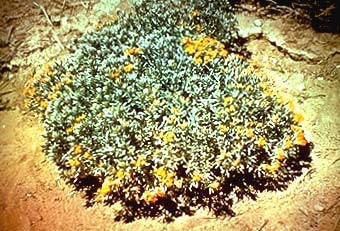


Kochia (Kochia scoparia) is also called fireweed or burning bush. It can accumulate nitrates and oxalates and appears to be toxic to the liver; flowers, leaves and seeds are toxic. Most poisonings occur in cattle. Signs include lack of appetite, incoordination, jaundice, spasms, weakness, gastrointestinal irritation (vomiting and diarrhea), blindness, depression, recumbency, drooling and tearing, diarrhea, photosensitization and death. The plant’s toxins can cause extensive kidney and liver damage as well as polioencephalomalacia.
Tall fescue (Festuca arundinacea) is a common cultivated perennial grass that does well in droughty areas of the West. It can be infected with an endophyte (fungus) called Acremonimum coenophialum and this endophyte can cause fescue toxicosis or “fescue foot.” Signs of fescue toxicosis in non-equine livestock result from the vasoconstrictive properties of the main toxic agent, ergovaline. These signs are lameness, elevated temperature and gangrenous extremities (tail, feet, ears). In mild cases, signs may include unthriftiness and poor rates of gain. In horses, signs of fescue toxicosis are prolonged pregnancy, abortion, difficult labor, retained placenta, thickened placenta, lack of milk production and a variety of neonatal foal abnormalities. Fescue toxicosis can be prevented by using certified endophyte-free seed when seeding tall fescue pastures and by testing suspect hay for endophytes.
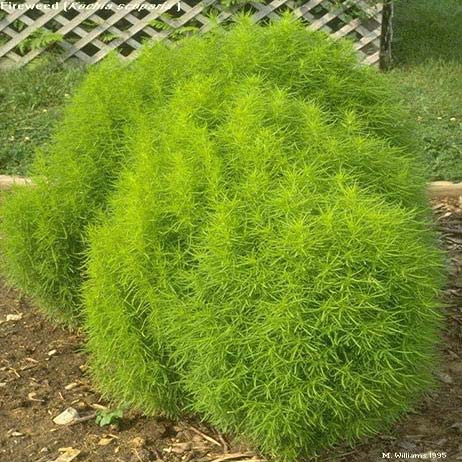



Cultivated grasses such as oats (Avena sativa), wheat (Triticum aestivum), rye (Secale cereale), barley (Hordeum vulgare), corn (Zea mays) and Sorghum species (Johnson grass, Sudan grass, millet, sorghum) are associated with livestock illness through a variety of mechanisms. All can accumulate toxic levels of nitrates, especially after heavy fertilization, drought, or periods of rapid growth. Ingestion of these plants during periods of rapid growth can also cause grass tetany (hypomagnesemia) in livestock; signs are weakness, muscle tremors, incoordination, staggering, recumbency, seizures, coma and death if not treatment is given. Oats, rye, barley and corn can all become moldy with ergots; ergots can cause signs that reflect liver and brain cell damage, blood vessel constriction and estrogen-like effects. Sorghum species can also cause cyanide poisoning. All the above grasses can cause photosensitization, as well. To prevent poisoning, prevent livestock from ingesting plants in the rapid-growth phase or provide supplemental magnesium; do not feed moldy feed; test nitrate levels in feeds during droughts; do not feed Sorghum species that are less than two feet high; do not feed wilted, damaged, or partially-cured hay or green chop made from the plants listed above; allow silage to air out before feeding.



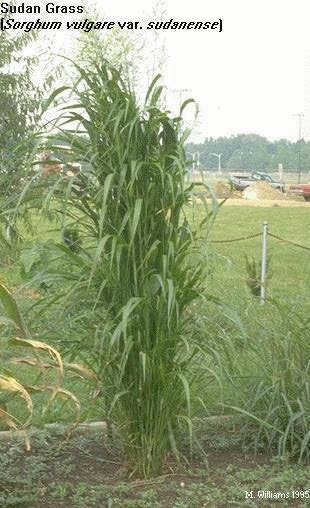
Sneezeweeds (Helenium hoopesii or H. microcephalum) are non-native plants usually found at elevations over 5,000 feet; they are common on mismanaged or overgrazed pastures but are not common in Washington. Their toxic agent is helenalin and other lactones. Signs of poisoning usually appear after a prolonged period of exposure to the plant, especially if few other forages are available. These signs include wasting, depression, profuse vomiting (sneezeweed poisoning is called “spewing sickness”), salivation, stiffness, weakness, secondary pneumonia and death. Animals can recover completely if they are removed from sneezeweed source immediately; animals exposed for longer periods of time die after a few days or up to several weeks later. There is no specific treatment; avoid prolonged exposure to plant.
Bracken fern (Pteridium aquilinum) causes two different types of poisoning depending on the species of animal affected. It contains thiaminase, which is an enzyme that destroys thiamin (Vitamin B1, which is essential for proper energy metabolism). Signs of poisoning in monogastrics (horses, swine) are those of chronic thiamin deficiency and include weakness, depression, muscle tremors, incoordination, decreased heart rate, base-wide crouching stance, poor rates of gain, poor appetite and weight loss, recumbency and convulsions. Because their rumen microflora produce thiamin, cattle and sheep do not show the signs of thiamin deficiency that horses and swine do. Bracken fern also contains a carcinogen; most typically, bladder tumors result in cattle and sheep. This fern has another unidentified compound that causes severe suppression of bone marrow activity in ruminants, especially cattle. Signs of toxicity include a marked fever, bloody urine and hemorrhage from multiple orifices (“chronic enzootic hematuria” or “acute hemorrhagic syndrome”). This plant is not highly palatable and is usually eaten only if other forage sources are unavailable or if incorporated into hay. The hemorrhagic form in cattle and sheep is usually fatal, but the condition that arises from chronic ingestion of thiaminase by horses or swine is responsive to thiamin injections and treated animals recover completely. Avoid poisoning by limiting access to plants and insuring access to other forage.
Horsetail (Equisetum arvense) also contains thiaminase, so signs of poisoning are similar to the thiamin deficiency caused by bracken fern. It is unpalatable and access to other quality forage should help protect against cases of toxicity.
Clovers (Trifolium species) are a large portion of the legume family and many are valuable forages. Nevertheless, various species can cause problems including bloat, photosensitization (“trifoliosis” or “dew poisoning”), slobbering, founder, fetal malformations and various reproductive disturbances. The latter are caused by the estrogen-like compounds found in some clovers; signs include infertility, precocious mammary development, dystocia, uterine prolapses and cystic ovaries. Clovers can also accumulate nitrates and produce cyanogenic toxins. Prevent dew poisoning by letting alsike clover dry before letting livestock graze it.



Alfalfa (Medicago sativa) is an excellent forage for livestock throughout the U.S. Nevertheless, it can cause catastrophic illness in livestock if not managed carefully. Alfalfa contains compounds that can cause bloat due to the formation of stable bubbles within the rumen. It also contains phytoestrogens and coumestan, which can cause cystic ovaries, irregular cycles, lack of estrous and lack of ovulation. This legume can also cause photosensitization. Most bloat problems associated with alfalfa ingestion can be controlled through common management practices.
Poison hemlock (Conium maculatum) is less toxic than water hemlock but still often lethal. It is a biennial plant in the parsley family; its roots can be mistaken for wild parsnips. Poison hemlock prefers to grow in wet areas such as creekbeds or ditches but can also be found along roads. All plant parts are poisonous. Signs of poisoning include drooling, depression, regurgitation, bloat, dilated pupils, nervousness, tremors, incoordination, frequent urination and defecation, rapid and weak pulse, blue mucous membranes, recumbency, respiratory paralysis, coma and death, often within a few hours after plant consumption; the affected animal’s breath and urine have a characteristic “mousy” odor. Swine apparently find poison hemlock palatable, although other livestock species do not. Cattle are much more sensitive to this plant’s toxic agents than are sheep. Pregnant cattle and pigs that survive exposure to poison hemlock can deliver malformed offspring. In cattle, the malformations can mimic those of crooked calf disease and the critical exposure time is similar (days 40-70 of gestation). Apparently, horses and sheep do not demonstrate fetal malformation as a manifestation of poison hemlock poisoning.
Water hemlock (Cicuta douglasii) is a very toxic plant. The toxic substance (cicutoxin) is found in all plant parts, but is concentrated in the roots; it has a strong carrot-like odor. Livestock rarely eat this unpalatable plant but may show interest in the root if the plant is uprooted. Signs of poisoning are usually fast in onset and progressive; they include rapid respiration and pulse, dilated pupils, drooling, muscle tremors, convulsions and coma, culminating in death from asphyxiation. This plant is usually found along stream banks and in other wet areas.
Arrowgrass (Triglochin maritima and/or T. palustris) prefers to grow in marshy areas and is a frequent component of native grass hay meadows. Its toxic potential increases if the plant is frosted or during periods of drought. Signs of poisoning are that of cyanide toxicity and can appear and progress rapidly; affected animals can be found dead or can display bright pink mucous membranes, respiratory distress, drooling, gasping, excitement, involuntary urination and defecation, twitching, convulsions, coma and death. The blood of poisoned livestock is bright red. Treatment and outcome is similar to that of other cyanide poisonings (see Prunus above).
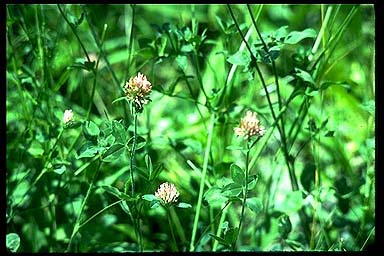
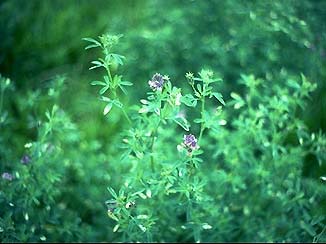







Lupines (Lupinus sericeus and other species) are native to the West; some species are toxic and others are not. Piperidine and quinolizidine alkaloids (especially anagyrine) are believed to be the toxic agent; they are primarily contained in lupine seeds and in young lupine plants. Sheep, cattle, goats, pigs and horses can all develop toxicity, but sheep are the most likely species to ingest lupines. Signs of poisoning include decreased appetite, rough coat, depression, twitching, incoordination, difficulty breathing, respiratory paralysis, convulsions and death. If pregnant cattle ingest a toxic species between days 40 and 70 of gestation and survive, they may deliver malformed calves (“crooked calf disease”) or abort. There is no treatment for lupine poisoning, but if animals live they usually make a full recovery. The toxic agent may be passed in livestock milk and if ingested by pregnant females of other species (humans, cats, dogs, etc.) may cause birth defects in those offspring.



Locoweeds and milkvetches (Oxytropis species and Astragalus species) are members of the legume family and are very common on Western rangeland. They are responsible for a large number of plant poisonings of grazing livestock in the West; horses are especially susceptible to locoweed. Varieties of these plants can poison animals in one of three ways: through accumulation of toxic levels of selenium, through an indolizidine alkaloid (swainsonine) or through a nitropropanol glycoside (miserotoxin). Generally, large amounts of the plants have to be ingested over a long period of time before toxicity occurs.
Signs attributable to chronic selenium toxicity include poor growth, hair loss, reproductive failure, sore feet and death. Other signs of locoweed poisoning are emaciation, depression, incoordination, trembling, difficulty eating and drinking, abortions and malformations, irregular gait, nervousness and excitability, staring, hindquarter paralysis, “goose-stepping,” disorientation, recumbency, death and “high mountain disease” of cattle. The latter is associated with grazing in high altitudes and manifests itself by signs of congestive right- sided heart failure: fluid accumulation under the jaw, in the brisket and in the abdomen; difficulty breathing; pronounced pulses and distended veins; profuse diarrhea; marked weakness; and death.
Locoweed and milkvetches are not very palatable, but once some individuals eat them they become addicted and seek these plants out. These toxic plants can appear early in the spring when nothing else is available as a forage source. There is no treatment for poisoning with these plants other than removing them from the source as soon as signs are first spotted; avoid grazing areas that contain locoweed and milkvetches.




Ponderosa pine (Pinus ponderosa) is a tree native to the West. Fresh and dry needles and young plants are toxic, especially to cattle in the last half of gestation. Signs of poisoning include abortion, stillborn or weak calves, retained placentas, depression, edema of the vulva and udder, excessive uterine bleeding and death from complications of abortion. Not all pregnant cattle abort and other livestock seem resistant to toxic effects. Abortion can occur from two days up to two weeks after a single exposure to needles. Lessen cattle’s likelihood of exposure by ensuring adequate forage intake, especially during winter and/or last half of pregnancy.




False hellebore (Veratrum californicum) is an early-emerging plant that can be found in moist mountain meadows. It causes a unique condition in lambs born to a ewe that has ingested the plant on day 14 of gestation: affected lambs are born with a variety of craniofacial malformations (cyclopia or “monkey face”). False hellebore’s poisonous steroidal alkaloids can also cause illness in ewes, cattle and goats; signs are drooling and frothing, vomiting, slow and irregular heartbeat, weakness, difficulty breathing, paralysis, convulsions and coma. Its toxic potential is greatly reduced after it is damaged by frost. Although there is no treatment for congenitally-deformed lambs, ill adult animals can be treated with atropine or epinephrine.
Halogeton (Halogeton glomeratus) is a palatable plant that invades land which has been burned, overgrazed or otherwise damaged. Although its range is spreading throughout the West, it is uncommon in Washington. Halogeton’s toxic component is sodium oxalate which causes oxalate crystals to form in the kidneys and rumen wall. Signs of poisoning include depression, difficulty breathing, weakness, bloat, gastrointestinal irritation (vomiting and diarrhea), salivation, recumbency, coma and death. Chance of poisoning is decreased if animals also consume adequate amounts of acceptable forage and water; alfalfa is of particular value as a preventative, as is dicalcium phosphate. Poisoning is most likely if a large amount of halogeton is eaten in a brief period of time. There is no treatment.
Black locust (Robinia pseudoacacia) is a fast-growing shrub or ornamental tree. It is potentially toxic to all grazing animals, but horses are particularly sensitive to its toxic effects. Its bark, leaves and seeds contain toxalbumins, including robinin. Signs of poisoning include lack of appetite, diarrhea, weakness, depression, founder, weak pulse, hindquarter paralysis, cold extremities, dilated pupils and colic; death can occur but is rare. There is no specific treatment and recovery is slow.
Fiddleneck or tarweed (Amsinckia intermedia) causes “walking disease” in horses and “hard liver disease” in cattle and hogs; sheep seem resistant to toxicity. The seeds contain an unknown agent that is toxic to liver cells. Signs of illness include weight loss, poor body condition and mild jaundice; horses show additional signs of nervous system involvement including aimless wandering, depression or delirium. The plant is unpalatable and seeds are consumed only when no other forage is available or when tarweed seeds contaminate livestock grain.



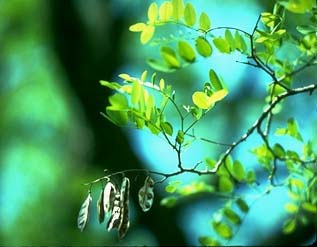


Tansy ragwort (Senecio jacobaea) is common on Western rangeland and is toxic both fresh and dry. Being unpalatable, it is only consumed when other forages are unavailable or it contaminates harvested forage. Its pyrrolizidine alkaloids are toxic to liver cells and cause chronic cirrhosis-like injury. Signs of toxicity can appear months after the plant was ingested and include lethargy, poor appetite, weakness, nervousness, colic, aimless wandering, blindness, abdominal distension, incoordination, jaundice, coma and death due to liver failure. Diagnosis can be made via liver biopsy or liver function tests.
Nightshades (Solanum species) are many; this genus includes many potentially-poisonous members such as potato, horse nettle and many nightshades. Tomatoes are closely-related to this genus and contain the same toxic agent. Signs of poisoning with tomato vines, green tomatoes, green potato skins, potato sprouts and parts of other plants in the Solanum genus are due to the toxic alkaloid called solanine. These signs can include lethargy, drooling, difficulty breathing, tremors, colic, vomiting, diarrhea or constipation, weakness, coma, widely-dilated pupils, paralysis, convulsions, coma and death.
Brassica species and other members of the mustard family (kale, cabbage, rape, turnips, etc.) contain toxic glucosinolates in fresh and dry seeds and vegetative parts. Some species can cause goiter; others contain a toxin that causes hemolytic anemia. Most cases of poisoning involve cattle. Signs include decreased appetite, drooling, reduced rate of gain, anemia, weakness, severe vomiting and diarrhea, staggering, photosensitization, paralysis, abortion, collapse and death. New cultivars have been developed with greatly-reduced levels of toxins and are generally safe to feed to livestock.
Prickly lettuce (Lactuca scariola) can cause pulmonary emphysema in cattle. Young plants are most toxic; mature and dried plants appear to be non-toxic. Also known as China lettuce, this plant can also accumulate nitrates. Cases of poisoning are typically seen in the spring and after fall re-growth. Signs of toxicity include audibly-labored breathing and weakness. On autopsy, lungs are markedly emphysematous (bulging with trapped air).











Yellowstar thistle (Centaurea solstitialis) and Russian knapweed (Centaurea repens) are non-native noxious weeds that are common throughout the West. They are toxic to horses if consumed for a prolonged period. Plants are generally unpalatable but will be eaten if little other forage is available; horses can then become habituated to it. Leaves, stems and fruit contain an unidentified toxin that causes death of a localized area of the equine brain; death of this brain area results in the classic signs of “chewing disease:” affected horses drool, have difficulty swallowing, chew and yawn excessively and lack tone in facial muscles. Other signs include aimless walking, head pressing against solid objects, facial swelling and restlessness. There is no treatment; all cases are eventually fatal due to starvation, dehydration or secondary pneumonia.
Larkspurs (Delphinium species) are cultivated and found wild. Seeds and young plants are most toxic; toxic agents (diterpenoid alkaloids) are found in all fresh and dry plant parts. Signs of poisoning are drooling, vomiting, bloat, nervousness, weakness, staggering, constipation, arched back, base-wide stance, paralysis, falling and death; excitement exacerbates all signs. Cattle account for the majority of cases of poisoning because they find the plants quite palatable; sheep and horses are poisoned less frequently. There is no treatment. Lessen chance of ingestion of larkspurs by insuring adequate grass development before animals are turned into areas containing larkspurs.
Sweet clover and white sweet clover (Melilotus officinalis and M. alba) are common forages and weeds. They are non-problematic if consumed fresh; they become toxic if leaves and stems are harvested and fed as hay or silage. Potentially-toxic hay may look and smell normal. Sweet clover contains coumarin, which is non-toxic. After harvesting, however, molds convert coumarin into dicoumarol, which is a potent anti-clotting factor. Signs of toxicity include lameness, bruises, hematomas and excessive bleeding; animals may have bloody noses, bloody feces and excessive bleeding from wounds or incisions. Treatment consists of Vitamin K injections and/or blood transfusions. Varieties of sweet clover low in coumarin have been developed. Avoid feeding any damaged or harvested sweet clover.
St. Johnswort (Hypericum perforatum), a common weed, contains a photosensitizing toxin called hypericin. The plant is toxic both fresh and dry. Two to 21 days after animals consume the plant, they display signs of photosensitization: unpigmented skin becomes inflamed and itchy and large areas may slough; although signs of liver disease are rare, they may also go blind, convulse and die. Treatment consists of removing the source of toxicity, protecting affected animals from sunlight and giving steroids to reduce inflammation. Livestock usually ignore St. Johnswort unless there is little else to eat, such as in early spring or on poorly-managed rangeland.






Buttercups (Ranunculus species) are a very common weed. Probably all species contain a glycocide called ranunculin, which is split into a chemical called protoanemonin when the plant is eaten. Protoanemonin is an irritant that causes blisters and severe inflammation when it contacts tissues; the gastrointestinal tract is usually affected. Buttercups are non-toxic if they are consumed dry, such as in hay. Signs of poisoning can be seen in all species of grazing livestock and include drooling, nasal discharge, diarrhea, colic, depression or excitation, labored respiration, a wobbly gait and sometimes blindness. Convulsions followed by death can occur. Buttercups are very unpalatable, but if they crowd out desirable forage and dominate a pasture, animals may be forced to eat them. Some animals develop a preference for buttercups and will seek them out. This plant should be actively eradicated from pastures and rangeland.
Black walnut (Juglans nigra) can poison horses, dogs and perhaps other species. This large tree is a common ornamental and woodlot tree. Horses are most frequently poisoned when they are bedded with black walnut shavings; as little as 20% of the shavings need to be from this tree for toxicity to result. Signs of illness include laminitis (founder), respiratory difficulty and inflammation of the intestinal tract; if shavings are eaten, colic can occur. Chances of recovery are good if animals are removed from black walnut shavings immediately after signs of toxicity are notices. Avoid using black walnut shavings for horse bedding and limit horses’ access to black walnut trees in pastures.


Oaks (Quercus species) are common throughout the U.S. and most species are believed to be toxic. The toxic agent, gallotannin, is concentrated in young leaves, acorn buds and green acorns. Most poisonings happen in the Spring or Fall and occur in sheep and cattle. The toxin affects the kidneys and gastrointestinal tract. Signs of illness include poor appetite, emaciation, constipation followed by diarrhea, frequent urination, depression, excessive thirst and death. Calcium hydroxide may help prevent toxicity if oaks cannot be avoided as forage and it may be used as treatment if kidney damage is mild; more severe cases rarely survive.
Foxglove (Digitalis purpurea) is a common garden flower and sometimes a wild escapee. It contains several cardiac glycosides including digitalin, digoxin and digitoxin; the toxins are active in the fresh, dried, or even boiled plant. Signs of poisoning are colic, frequent urination, vomiting, diarrhea, trembling, irregular and slow heart beat, convulsions; death is rare. Atropine helps relieve cardiac signs. Prevent by limiting livestock’s access to flower gardens.
Elderberry (Sambucus canadensis) is a native shrub that prefers to grow in moist areas. It contains two toxic agents: a cyanogenic glycocides and a cathartic. All plant parts should be considered toxic, especially the roots; the berries are harmless once cooked. Signs of toxicity are usually related to severe gastroenteritis: vomiting, diarrhea and colic. In severe cases of poisoning, signs of cyanide poisoning may also occur and include difficulty breathing, elevated respiratory rate, convulsions and death.





Jimsonweed (Datura stramonium) is also called thornapple, which is more descriptive. It is common in waste areas, barnyards and heavily-used livestock areas; it prefers rich soils. Jimsonweed contains three toxic tropane alkaloids: atropine, scopolamine and hyoscyamine; all parts of the plant are toxic. The weed is unpalatable, so most cases of poisoning occur when no other forage is available or if the weed contaminates hay, silage or grain. First signs of poisoning include elevated pulse and respiration rates, dilated pupils, diarrhea, frequent drinking and urinating, nervousness, muscle twitches, depression, loss of appetite and loss of condition. Later and in more severe cases, affected animals have a weak pulse, breath irregularly, have a low body temperature, convulse, enter a coma and die. This plant can poison many animals by contaminating feed, so it should be eradicated from pasture or rangeland when possible.
Dock or sorrel species (Rumex species) are common in poor, gravely and disturbed soils. They can accumulate oxalates and sometimes nitrates in their leaves and stems to varying degrees and if consumed in great quantity (such as in early spring or when no other forage is available), can cause oxalate poisoning. Poisoned animals lose their appetite, stagger, are depressed, have muscle tremors, lie down, become comatose and may die. Signs mimic those of milk fever because oxalates bind blood calcium, so animals appear clinically hypocalcemic; oxalates also cause severe kidney damage.
Milkweeds (Asclepias species) are toxic to livestock but are unpalatable and rarely eaten. The leaves, pods, seeds and sap of various species are toxic. Milkweeds are common in ditches, waste areas and field edges. They are not palatable and are ingested when no other feed source is available. Toxicity is due to several cardiac glycosides. Signs of poisoning are most common is sheep and include loss of appetite, labored breathing, fever, pupil dilation, agitation, bloat, weakness, trembling, recumbency, depression, convulsions and death.








Conclusions
Management practices that livestock producers can take to minimize losses due to plant poisonings include avoiding grazing areas when particular toxic plants are prevalent; providing plenty of water, salt, or other supplements; feeding hay or providing another forage source before turning livestock out on potentially- problematic range; avoiding overstocking or overgrazing; and controlling or eliminating poisonous plant species where possible.
For more information about poisonous plants common in a particular area, contact your county Cooperative Extension educator, veterinarian, noxious weed control board or USDA Service Center.
References on Poisonous Plants
- Hulbert, Lloyd and Oehme, Frederick W. (1981). Plants poisonous to livestock: selected plants of the United States and Canada of importance to veterinarians. Manhattan, KS: Kansas State University Printing Service.
- James, Lynn et al. (1980). Plants poisonous to livestock in the western states. Washington, DC: USDA. [Agriculture information bulletin no. 415]; available on-line at www.pprl.ars.usda.gov/Poisonous_Plants.htm.
- James, Wilma (1973). Know your poisonous plants: poisonous plants found in field and garden. Healdsburg, CA: Naturegraph Publishers.
- Johnson, Charles Grier, (1993). Common Plants of the Inland Pacific Northwest. Washington, DC: U.S. Government Printing Office.
- Kingsbury, John (1964). Poisonous plants of the United States and Canada. Englewood Cliffs, NJ: Prentice-Hall, Inc.
- Schmutz, Ervin and Hamilton, Lucretia Breazeale. (1979) Plants that poison: an illustrated guide to plants poisonous to man. Flagstaff, AZ: Northland Press.
- Southern Weed Science (6th Ed.). Weed Identification Guide.
- The Merck Veterinary Manual (1991). Eighth Rahway, NJ: Merck and Co., Inc.
- Turner, Nancy and Szczawinski, Adam F. (1991). Common poisonous plants and mushrooms of North America. Portland, OR: Timber Press.
- Woodward, Poisonous plants: a color field guide. (1985). New York: Hippocrene Books Inc.
Poisonous Plants Web Sites
http://www.ansci.cornell.edu/plants/ http://res.agr.ca/brd/poisonpl/title.html http://www.pprl.ars.usda.gov/Poisonous_Plants.htm http://vet.purdue.edu/depts/addl/toxic/cover1.htm http://cal.vet.upenn.edu/poison/index.html http://www.library.uiuc.edu/vex/toxic/intro.htm
The information herein is supplied for educational or reference purposes only and with the understanding that no discrimination is intended. Listing of commercial products implies no endorsement by WSU Extension. Criticism of products or equipment not listed is neither implied nor intended. Some medications mentioned herein are available only by prescription and other drugs are not labeled for use in all species. These drugs can only be used on the advice of a licensed veterinarian when a veterinarian-client-patient relationship exists. Other use violates federal law. Consult your veterinarian about the extra-label use of medications. Extension programs and policies are consistent with federal and state laws and regulations on nondiscrimination regarding race, color, gender, national origin, religion, age, disability and sexual orientation. Evidence of noncompliance may be reported through your local Extension office.